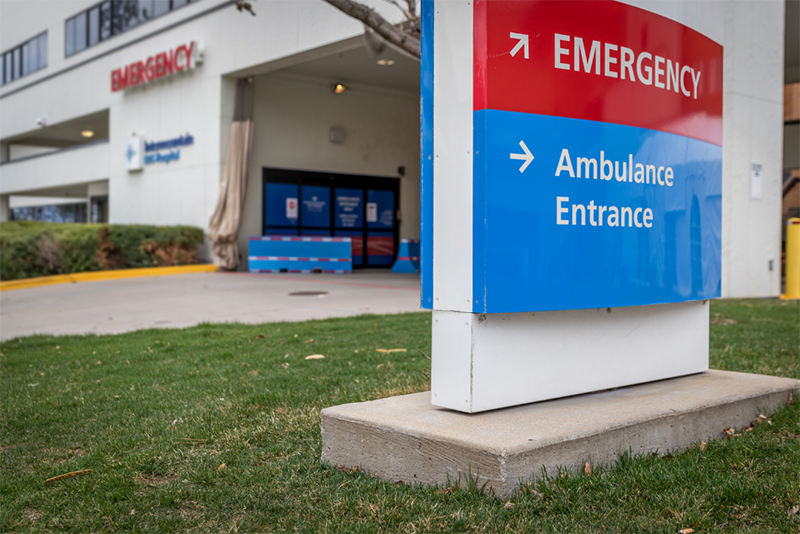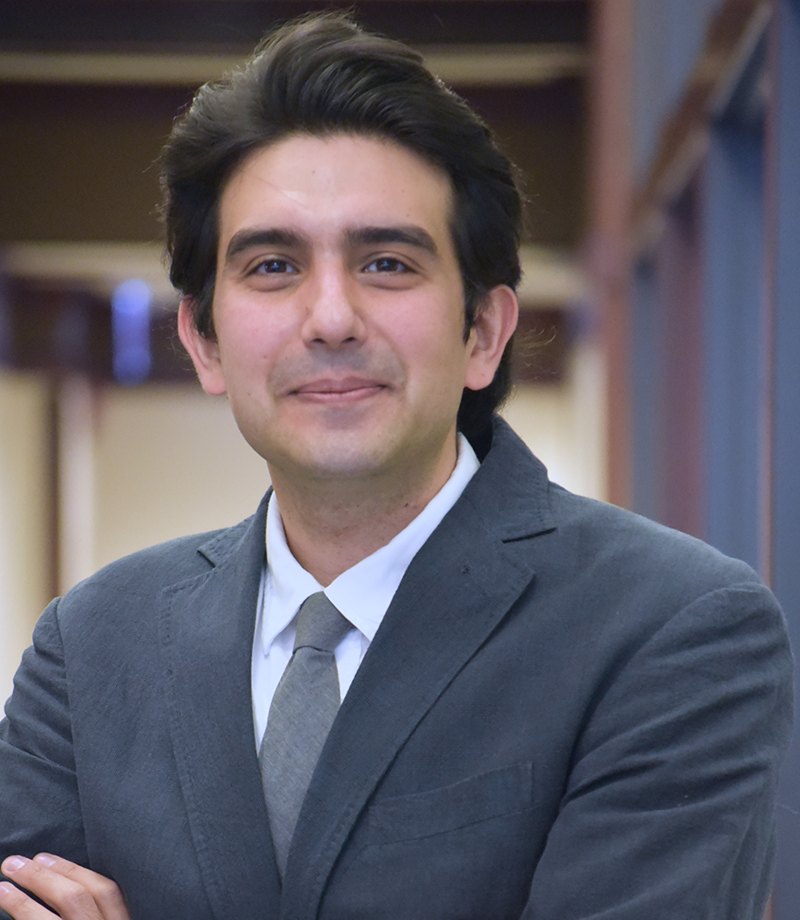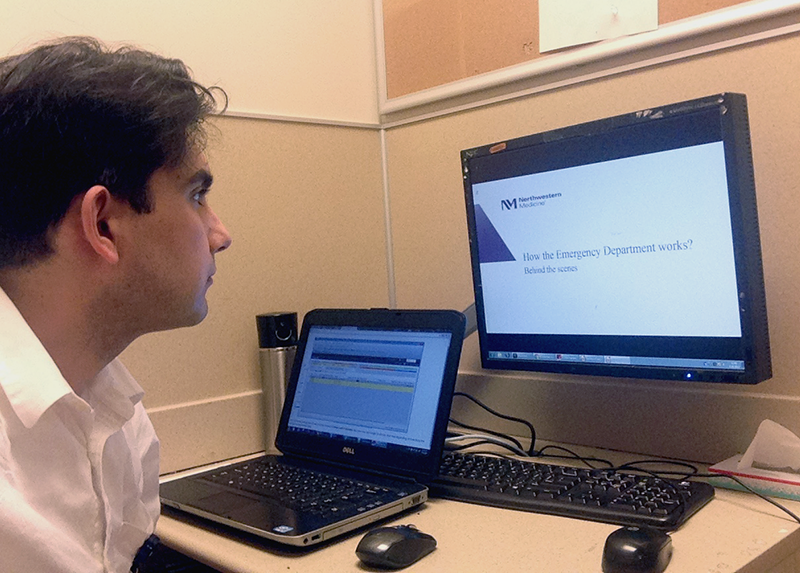 As part of his doctoral dissertation, Assistant Professor of Management Sina Ansari collaborated with the Northwestern Memorial Hospital Emergency Medicine department to study the impact of announcing wait times on patient satisfaction.
As part of his doctoral dissertation, Assistant Professor of Management Sina Ansari collaborated with the Northwestern Memorial Hospital Emergency Medicine department to study the impact of announcing wait times on patient satisfaction.
Several years ago, DePaul Assistant Professor Sina Ansari rushed to NorthShore Evanston Hospital’s emergency department after tearing his anterior cruciate ligament (ACL) during a soccer tournament game. At the time Ansari was a doctoral student pursuing a degree in industrial engineering and management sciences at Northwestern University, where he was part of a soccer league with fellow students. Although the waiting room did not seem crowded, Ansari ended up waiting two hours while experiencing pain in his leg. When he asked hospital representatives about the wait time, they told him they didn’t know.
Long wait times are not uncommon in emergency rooms. In 2017, more than 22 million ER visits involved more than an hour of waiting, according to the Centers for Disease Control and Prevention. As part of his doctoral thesis, Ansari partnered with Northwestern Memorial Hospital Emergency Medicine to determine if announcing wait times improved patient satisfaction, even if hospitals are unable to shorten the wait time for ER patients. His multi-year research project is currently under review for publication.
“This excessive wait time is the reason why most patients become dissatisfied or leave the emergency room, which has negative consequences, not only for the patient but also for the hospital,” Ansari says. “So we saw this opportunity to provide some strategies or policies to make patients’ experiences a little bit better.”
Early in his career, Ansari, who graduated with bachelors and master’s degrees in industrial engineering from the Iran University of Science and Technology, has always been fascinated with the temporal aspects of service delivery and the connection between customers and service providers. Few scholars have published research on the topic and typically focus on the monetary outcomes of service design.
But what Ansari did find in the available research is that announcing wait times to customers improves customer satisfaction – regardless of industry. “If you announce the wait times, you can reduce anxiety and therefore improve customer satisfaction and improve the waiting experience,” he says. However, he points out that there is little research on what wait times should be announced and how communicating a long or short delay would impact patient satisfaction.
Patient Satisfaction Impact on Business Outcomes
To determine the best delay-announcement strategy, Ansari and his co-researchers ran an experiment in the Northwestern Memorial Hospital in downtown Chicago. They found that even announcing a delay improved patients’ self-reported satisfaction by 18 percent. They also found that patients are loss averse: patients who wait longer than announced are more dissatisfied than patients waiting the same amount of time but are given overestimates.
 Assistant Professor of Management Sina Ansari | Photo by Kathy Hillegonds
Assistant Professor of Management Sina Ansari | Photo by Kathy Hillegonds
“That kind of tells us in order to maximize the waiting experience we have to overestimate,” Ansari says. “Forecasting models are not as accurate as we wish, but with a little bit of a buffer, we can make sure we are at least within the range where we can satisfy the patients the most.”
Research also has shown that patient satisfaction relates directly to businesses’ bottom lines, particularly for hospitals. Since 2012, patient scores have played a pivotal part in hospital Medicare reimbursements through the Hospital Value-Based Purchasing Program. According to the program, the higher a hospital’s patient satisfaction scores, the higher their reimbursements will be, and vice versa. Patient satisfaction can also have an overall impact on health outcomes as well, Ansari says.
“Satisfaction matters, especially in the emergency department, because patients matter,” he says. “There are some studies that show that improving patient satisfaction is correlated with improving health outcomes, like lowering mortality rates, because if you improve patient satisfaction, it will end up changing some guidelines and policies and, at the end of the day, will improve the health satisfaction.”
Providing Transparency to Customers
Ansari’s findings led him to create a statistical learning model that allowed the Northwestern Memorial Hospital Emergency Medicine department to accurately announce wait times for patients. The model incorporates a variety of factors, some of which include the time of day, day of the week and the volume of people in the room. All of the information is collected in real time, allowing ER managers to announce wait times.
 Ansari spent several hours at the Northwestern Memorial Hospital Emergency Medicine department, conducting experiments and observing the hospital’s ER operations. | Photo courtesy of Sina Ansari
Ansari spent several hours at the Northwestern Memorial Hospital Emergency Medicine department, conducting experiments and observing the hospital’s ER operations. | Photo courtesy of Sina Ansari
Ansari believes the model can be applied to other hospitals and service industries, but says more research needs to be done in order to ensure that is the case.
Throughout the project, Ansari and his team of researchers and volunteers spent several hours in the Northwestern Memorial Hospital Emergency Medicine department, conducting experiments and observing the hospital’s ER operations. During one of his pilot studies, Ansari recalls patients approaching him to thank for him for his efforts and helping to communicate delay times.
“There were people who were not happy with the fact that they had to wait for four hours,” he says. “But they were at least happy that someone told them that this is the amount of time they have to wait to see the doctor.”
The delay-announcement strategy may not work for every situation but organizations will benefit if they’re willing to communicate with their customers, he says.
“The least we can do is provide some sort of transparency on what is going to happen, provide some estimation and that would hopefully give a better understanding for the customer and hopefully effect their satisfaction .”
This study was done in collaboration with:
-
Seyed M.R. Iravani, Department of Industrial Engineering and Management Sciences, Northwestern University
-
Laurens G. Debo, Tuck School of Business, Dartmouth College
-
Sanjeev Malik, MD, Feinberg School of Medicine, Northwestern Medicine
-
Northwestern Medicine Hospital’s Patient Engagement Department and all hospital emergency department staff.
Learn more about: